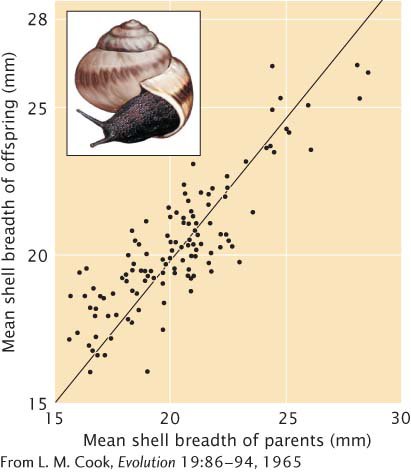Calculating Heritability
Now that we have considered the components that contribute to phenotypic variance and developed a general concept of heritability, we can ask how we might go about estimating these different components and calculating heritability. It is not possible to determine all the components of phenotypic variance from observation of the phenotypes alone, but the heritability of a characteristic can often be measured. The mathematical theory that underlies these calculations of heritability is complex, so here we will focus on developing a general understanding of how heritability is measured.
Most methods for calculating heritability compare the degree of resemblance between related and unrelated individuals or between individuals with different degrees of relatedness. For example, one method compares the phenotypes of parents and offspring with those of unrelated individuals. Another method compares the similarity of identical twins (which have 100% of their genes in common) with the similarity of nonidentical twins (which have 50% of their genes in common). The general idea is that if genes influence phenotypic differences among individuals, then individuals that are more closely related will be more similar in phenotype. Statistical methods called regression and correlation are used to determine the degree to which more closely related individuals are more similar in phenotype.
An example of calculating heritability by comparing the phenotypes of parents and offspring is illustrated in Figure 17.12. Here, the mean phenotype of the parents is plotted against the mean phenotype of the offspring. Each data point on the graph represents one family. The line represents the best fit to all the points on the graph (that is, deviations of the points from the line are minimized). A complex mathematical proof (which we will not go into here) demonstrates that the slope of the line equals the narrow-

All estimates of heritability depend on the assumption that the environments of related individuals are not more similar than those of unrelated individuals. This assumption is difficult to meet in human studies because related people are usually reared together. Heritability estimates for humans should therefore be viewed with caution.
CONCEPTS
Broad-
 CONCEPT CHECK 1
CONCEPT CHECK 1
If the environmental variance (VE) increases and all other variance components remain the same, what will the effect be?
Broad-
sense heritability will decrease. Broad-
sense heritability will increase. Narrow-
sense heritability will increase. Broad-
sense heritability will increase, but narrow- sense heritability will decrease.
a